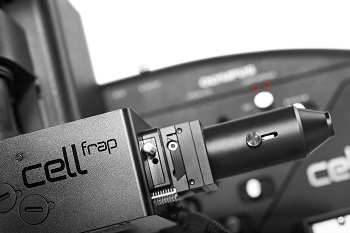Sep 1 2015
Olympus introduces a flexible and accurate cellFRAP imaging platform specifically for the acquisition, monitoring and analysis of dynamic in-vivo processes by photomanipulation techniques.

Enabling the easy addition of photomanipulation techniques to imaging platforms, Olympus has launched a new cellFRAP deck system for the popular IX3 ‘open source concept’ IX83 and IX73 microscopes. Olympus cellFRAP is designed with researchers in mind, providing highly accurate and flexible live-cell photomanipulation with various evaluation options for data presentation needs.
Unlike conventional widefield-based FRAP systems, Olympus’ cellFRAP employs a diffraction-limited laser spot for high-intensity and precise positioning of the bleaching region across the full field of view (FOV). This ensures that photomanipulation reaches every point in the FOV without needing to move the sample.
The system’s excellent spot quality allows full flexibility in position and shape of the bleaching region, and enables control of the bleaching area with extreme accuracy. Driven by the Olympus Real-time controller, the cellFRAP system achieves an unrivalled short switchover time of only 200 µs between bleach and post-bleach acquisition, ensuring detection of the most valuable initial sample response after stimulation.
A chromatically corrected beam path enables multi-laser stimulation without the need for re-alignment, providing the ability to use up to four different lasers during the same experiment. This is especially beneficial for sophisticated applications such as optogenetics.
Via incorporation into the Olympus IX3 open source frames, the cellFRAP deck can easily be adapted to an existing imaging platform with a full range of compatible accessories including the ZDC, incubation chambers, manual or motorised stages and manipulators. This allows photomanipulation experiments to be set-up in combination with other high-end systems, for example, spinning disk or TIRF.
cellFRAP is seamlessly integrated into the Olympus Life Science imaging software, cellSens. A straightforward auto-calibration wizard makes it easy to adjust the scanner to the camera. Using the cellFRAP solution in the cellSens Graphical Experiment Manager provides intuitive system set-up and experiment control.
This ensures excellent flexibility in experiment design and perfect synchronisation for maximum speed performance. Integration of any automated device is possible and even complex acquisition workflows can be easily defined and reproduced. The cellFRAP solution also includes a qualitative FRAP analysis for data evaluation. In addition, the Kymograph resembles timeline visualisation for easy extraction and presentation of data.
Tailored to the needs of photomanipulation, Olympus’ cellFRAP presents an ideal solution for researchers as an easy-to-use system that provides excellent optical performance, accuracy and µs-precise control.